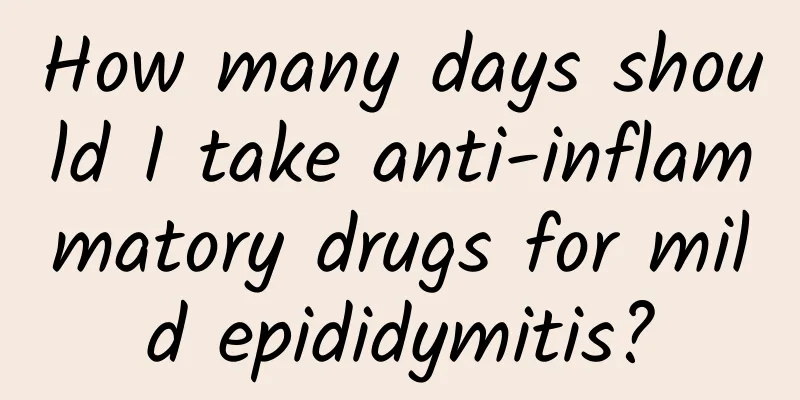How many days should I take anti-inflammatory drugs for mild epididymitis?

|
The epididymis is also a small part under the male reproductive organ, attached to the scrotum, providing a place for the growth and development of sperm. However, the epididymis is prone to disease due to the decline of the male's own physical fitness. When it is damaged by external stimulation, it will show symptoms such as inflammation and infection. At this time, anti-inflammatory drugs are needed to help the recovery of inflammation. So how many days can the anti-inflammatory drugs be used? Let's find out.
(1) The epididymis is not the testis. As the name suggests, the epididymis is a tissue near the testis. (2) The testicles are located in the male scrotum and their function is to produce sperm and synthesize male hormones. The epididymis surrounds and is tightly attached to the top of the testicle. The enlarged part at the top is the epididymis caput, and the tapering part at the bottom is the epididymis cauda. (3) The epididymis is where sperm mature and store. What is epididymitis? When men's immunity decreases, E. coli, Staphylococcus, Mycobacterium tuberculosis, Neisseria gonorrhoeae and Chlamydia may cause epididymitis. Epididymitis is a common infection of the male reproductive system. The peak age range is 19 to 35 years old (actually, it can occur in infants to the elderly). Because this age range is the sexually active period for men, they are more susceptible to infection. What are the types of epididymitis? Epididymitis can be divided into two types: acute epididymitis and chronic epididymitis according to the characteristics and symptoms of the disease. What are the symptoms of acute epididymitis? (1) Obvious scrotal swelling and pain, redness of the scrotal skin, and pain that can radiate to other parts of the body such as the groin and lower abdomen. The pain becomes more severe and unbearable when standing or walking, and is often accompanied by a fever. (2) May be accompanied by symptoms of frequent urination and urgency. What are the symptoms of chronic epididymitis? The symptoms of different patients with chronic epididymitis vary greatly. (1) Patients may experience pain and discomfort in the lower abdomen, groin, or scrotum, which may be unilateral or bilateral. There is often a history of irregular epididymal swelling and pain. (2) The pain sensation varies from person to person. Some may experience mild discomfort, while others may experience obvious scrotal pain. (3) When touching the epididymis, it may be found to be slightly enlarged and hardened, with mild tenderness, and in some cases, a swollen nodule may be found. How does epididymitis occur? (1) Since the tail of the epididymis is connected to the vas deferens and opens into the prostate and posterior urethra, and the urethra is connected to the outside world, various microorganisms or bacteria can flow back from the urine into the vas deferens and cause epididymitis. (2) Bacteria may also spread through the blood and stay in the epididymis to reproduce, thus causing epididymitis, but the probability of this type of blood infection is relatively low. What are the pathogens that cause epididymitis? Epididymitis is mainly caused by bacteria, viruses, etc., and some pathogenic microorganisms or parasites of unknown etiology are also caused. Common pathogens include E. coli, Staphylococcus, Mycobacterium tuberculosis, Neisseria gonorrhoeae and Chlamydia. At what age does epididymitis occur most often? Epididymitis is a common infection of the male reproductive system, with the peak age of onset being between 19 and 35. years old (actually it can happen to anyone from infants to the elderly), because this age group is the sexually active period for men and is therefore susceptible to infection.
It is possible, but it is not common. Frequent masturbation can cause repeated congestion of the prostate and may also cause the reflux of urine containing bacteria. If you do not pay attention to hygiene, it is easy for bacteria or microorganisms to enter the urethra, causing diseases such as epididymitis or prostatitis. Does chronic epididymitis develop from acute epididymitis? Partly yes. Chronic epididymitis is relatively common in clinical practice. It is generally believed that chronic epididymitis may turn into chronic disease due to failure to receive thorough treatment in the acute phase. Some patients often have chronic prostatitis, which may be caused by the spread of chronic prostatitis or reflux of urine with bacteria. However, some patients often have no history of acute attacks before this. What tests should be done for epididymitis? (1) The symptoms of epididymitis are relatively obvious and can be identified by a careful physical examination by a doctor. (2) However, a urine routine examination and scrotal ultrasound examination are generally required to confirm the diagnosis and rule out other similar diseases such as testicular torsion, testicular trauma, prostatitis, etc. Acute epididymitis and testicular torsion have similar symptoms. How to differentiate them? Acute epididymitis is most easily confused with testicular torsion. Both are acute diseases within the scrotum. The clinical manifestations are similar, but the treatment methods are completely different. Therefore, when it is difficult to distinguish, a scrotal color Doppler ultrasound is required for identification. The main symptoms of acute epididymitis are scrotal swelling and pain, redness of the scrotal skin, and some patients have symptoms such as frequent urination, urgency, and fever. During physical examination of epididymitis, a significantly enlarged epididymis will be found, which is tender and the testicles are sometimes also enlarged. The pain is relieved when the scrotum is lifted up. The levator testis reflex is present. Testicular torsion is more common in adolescents. The spermatogenic function of the testicles is impaired after 2 hours , and the testicles will become necrotic after 6 hours. The main clinical manifestations of testicular torsion are scrotal pain and scrotal swelling, but the body temperature generally does not rise. During the examination of testicular torsion, the testicles are in an abnormal position, tenderness is obvious, the levator testis reflex disappears, and the pain does not decrease when the scrotum is lifted. How to differentiate chronic epididymitis from chronic prostatitis? The symptoms of chronic epididymitis and chronic prostatitis are similar. Both have a long course of disease and may cause pain and discomfort in the scrotum, lower abdomen, groin and other parts of the body. The pain symptoms are sometimes mild and sometimes severe. Although the clinical manifestations are similar, it is still easy to distinguish between the two. Physical examination of chronic epididymitis can reveal enlargement or nodules at the head or tail of the epididymis, while the size and shape of the testicles and epididymis in chronic prostatitis are generally normal, but the prostatic fluid examination is often positive. In addition, color Doppler ultrasound examination of the urinary system can be used for differentiation. Is epididymitis easy to cure? The treatment of epididymitis is not complicated and most cases can be cured, but early diagnosis and treatment are the key. If you have symptoms suspected of epididymitis, you should go to the hospital for emergency treatment immediately. Do not self-diagnose or take medicine at will. How is epididymitis treated? (1) General treatment: The general treatment of epididymitis includes bed rest, raising the scrotum to reduce the swelling, prohibiting physical activity and sexual intercourse, and applying ice packs in the early stages of the disease. (2) Antibacterial and analgesic treatment: Antibacterial treatment of epididymitis should first be based on bacterial culture and drug sensitivity test to select appropriate antibacterial drugs. If the test results are not available, quinolones can be used temporarily, and the decision can be made after the drug sensitivity results are available. In the early stage of acute epididymitis, the swelling and pain symptoms are severe, and lidocaine plus dexamethasone can be used for closed therapy, which can relieve symptoms in a short time and promote the absorption of inflammatory masses. (3) Surgery: Surgery is required in a few cases, such as when epididymitis symptoms do not improve or worsen after general treatment; when testicular or scrotal wall abscesses require incision and drainage to relieve pressure; and when the testicles and epididymis suffer from severe ischemia and hypoxia due to the spread of inflammation, which may affect the function, surgical treatment may be considered. Does epididymitis require surgery? Epididymitis generally does not require surgery, and conventional antibacterial drugs and symptomatic treatment are sufficient. However, in a few cases, surgical treatment may be considered, such as: (1) Internal medicine treatment is ineffective and the disease is prolonged and unrecoverable; (2) Severe scrotal pain, high fever, and epididymis purulent in the scrotum; (3) Severe obstruction of blood circulation in the epididymis and spermatic cord.
You need to ask a doctor to make a diagnosis based on symptoms and examination results. If the symptoms of epididymitis disappear after standard treatment, such as the enlarged epididymis shrinks significantly to normal size, the pain disappears, the body temperature returns to normal, and the blood test results are normal, it can be considered cured. This treatment process generally needs to last at least 2 weeks. If the symptoms have not completely disappeared, the doctor will extend the treatment period as appropriate. Will epididymitis recur after it is cured? Epididymitis generally does not recur after it is cured, but it needs early and standardized treatment. The epididymis has a rich blood supply, and drugs can easily reach the lesions. If sensitive antibacterial drugs are selected for treatment, combined with bed rest, scrotal elevation and other general treatments, epididymitis treatment is not difficult, so there is no need to worry too much about recurrence. What is the induration caused by epididymitis? Generally, when the symptoms disappear after treatment, the nodules will not have much impact on the body. If there is obvious swelling and pain or it affects fertility, you should go to the hospital for treatment and surgical treatment. After the treatment of epididymitis, some people will feel a small nodule in the epididymal duct. This is a very common situation. Research surveys show that about 50% to 70% of patients will have it. This nodule is formed by the chronic inflammatory reaction and fibrous tissue hyperplasia of the epididymal duct. After the treatment of epididymitis is cured, some of these nodules may be absorbed and disappear, while others may still remain. What to do if epididymitis causes testicular atrophy? The biggest harm of epididymitis is that it may cause testicular atrophy, affect fertility, and lead to male infertility. If testicular atrophy is caused, it means that the testicular tissue on that side has been severely damaged, the seminiferous tubules have atrophied, and the spermatogenic function of the testicle on that side is generally difficult to recover, and treatment is difficult to be effective. Therefore, we should be alert to the occurrence of such complications. When acute testicular pain occurs, we should seek medical attention in time. Early diagnosis and treatment are the key. Will untreated epididymitis turn into epididymal cancer? There is no evidence that the two are related. The incidence of primary epididymal cancer is extremely low, and the pathogenesis is still unclear. There are very few reports on epididymal cancer worldwide, so there is no systematic research on epididymal cancer. Epididymal cancer progresses quickly and is more malignant. No studies have shown that epididymitis is associated with the occurrence of epididymal cancer. However, if epididymitis is not treated, severe scrotal pain often seriously affects the patient's quality of life. It can also spread to the testicles, causing epididymitis and damage to the testicles. In addition, if it turns into chronic epididymitis, it can affect the patient's health for a long time. Therefore, it is recommended that treatment measures should be taken in a timely manner once scrotal pain occurs. Will epididymitis heal on its own without taking medicine? will not. If epididymitis is not treated properly, it is difficult to recover with one's own immunity. In severe cases, it may even cause loss of epididymal function. If you have epididymitis, you should go to a regular hospital for diagnosis and treatment in time and do not misdiagnose the condition. Is the round mass felt on the epididymis the induration left by acute epididymitis? uncertain. If it is a residual hard nodule after the treatment of epididymitis, then there must be a history of epididymitis before. If there is no history of epididymitis, but a round mass can be felt in the epididymis, it is likely to be an epididymal cyst. If there is a history of tuberculosis and a cluster of round masses are felt, it is likely to be epididymal tuberculosis. These should be checked in the hospital as soon as possible. Will epididymitis affect the testicles and cause infertility? Yes, and it may lead to infertility. Epididymitis can directly spread to the testicles and cause orchitis, and the testicles will also become enlarged and painful. When the inflammation of the epididymis and testicles is severe, it will affect the blood supply to the testicles, causing testicular ischemia and hypoxia, metabolic products cannot be discharged in time, testicular damage, and in severe cases, it may even cause a decline in testicular spermatogenesis and testicular atrophy, leading to male infertility. Can I have sex if I have epididymitis? During the acute phase of epididymitis, all sexual activities should be prohibited and the amount of activity should be reduced. During the chronic phase, when the symptoms are severe, sexual life should be avoided as much as possible. If the symptoms are mild, it is okay to have sex occasionally, but it is best to wait until the disease is healed before having sex. Because the sexual organs will become congested during sexual impulses, if there is inflammation at this time, it is easy to cause the inflammation to spread, making it difficult to heal. How long after epididymitis is cured can I have sexual intercourse? There is no strict time limit for how long you should wait before you can have sex after epididymitis is cured. (1) In acute epididymitis, sexual intercourse is prohibited and can only be resumed after complete recovery; (2) During the standard treatment of chronic epididymitis, sexual intercourse is generally not encouraged. However, some patients with chronic epididymitis can have sexual intercourse in the absence of clear pathogenic bacteria infection, but it should not be too frequent. Does epididymitis affect fertility? Generally speaking, epididymitis will not affect fertility if it is properly diagnosed and treated. However, in rare cases, when the inflammation is severe, both epididymis may become blocked due to inflammation, which will make it difficult for sperm to be discharged, thus causing infertility. In this case, you should go to the hospital for unblocking surgery to restore your fertility. Does epididymitis affect semen quality? Yes. The epididymis is where sperm mature and are stored. If the epididymis becomes inflamed, it will affect the living environment of sperm, reduce sperm motility in semen, increase deformity rate, and reduce semen quality. If you have epididymitis, what should you pay attention to in your diet? Generally speaking, there is no need to avoid certain foods, just eat a balanced diet, but avoid eating too much greasy food, smoking and drinking. How to prevent epididymitis? Epididymitis is one of the common male reproductive system diseases. We should take the following measures to prevent it: (1) Don’t have sex too often. Moderate sex has its benefits, but if it is not done in moderation, it will cause long-term congestion of the reproductive organs and easily cause various male reproductive diseases. (2) Prohibit unclean sexual intercourse and insist on using condoms. (3) Learn about sexual physiology, develop good habits, and pay attention to sexual organ hygiene. |
<<: When I pinch my penis, it hurts inside. What anti-inflammatory medicine should I take?
Recommend
What causes men to have a fat belly?
Many middle-aged men have a fat belly, and it is ...
Male early acute symptoms
If patients with genital warts do not have physic...
How to completely remove body odor in men
Because body odor is hereditary, a lot of medical...
Chinese medicine for regulating male sexual function
For a man in daily life, having a strong body mak...
What to eat to treat impotence and premature ejaculation?
Premature ejaculation not only affects physical h...
How long does sperm survive in the body?
A man's sperm and a woman's egg must comb...
Urethra swelling after circumcision
In daily life, circumcision is quite common. Some...
Are prostate stones serious?
In recent years, the number of cases of prostate ...
The correct steps for men to wash their face
In this age where appearance is everything, every...
It is not advisable to run immediately after eating. Why?
Careful friends will find that when we were young...
Male eyebrow surgery
No part of the human body grows randomly, and eac...
How should men's urethral itching be treated?
Many men may experience urethral itching in their...
What are some simple wrinkle removal methods for men?
Nowadays, many male friends also pay more attenti...
What to do if you ejaculate due to excessive exercise?
Although we often advocate exercise, and exercise...
Why can't I get an erection the next day after sex?
If a man's penis cannot become hard at a crit...









